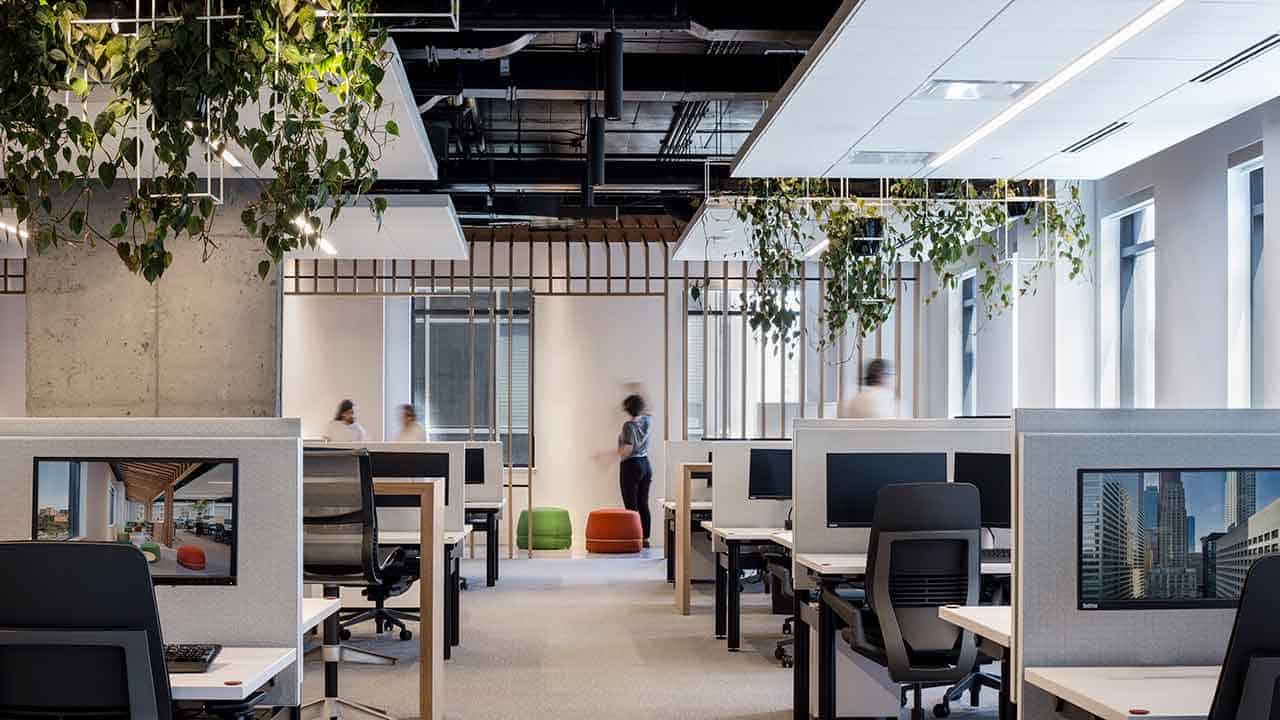Graced with a temperate climate the rest of Canada might envy, we who inhabit the BC Lower Mainland can grow all sorts of goodies. The one thing we can’t grow, however, is more land … least of all in our most densely populated cities where, increasingly, white collar workers spend their shifts in open plan offices. The job market, career opportunities, and workplaces of today often differ from that of 10+ years ago. Many business people, particularly young entrepreneurs, are strapped for capital and on the lookout for more affordable alternatives to traditional office design, so open plans are becoming more and more popular.

The one thing we can’t grow is more land … least of all in our most densely populated cities.
Meant to foster collaboration, open plan office spaces do present challenges around privacy and focused individual work. In the absence of well-designed acoustics, people find their own solutions. Headphone wear—publicly an almost universal symbol denoting “Stay outta my face”—may convey an unintentionally negative message in the workplace, when all we really mean is “I need to drown out the chatter so I can focus and get some work done.”

Quiet time. It’s not just for introverts.

Headphone wear—publicly an almost universal symbol denoting “Stay outta my face”—may convey an unintentionally negative message in the workplace.
So how do we plan spaces that accommodate the dual needs of teams and individuals? Hint: The word plan is key. If at all possible, it’s best to address these factors during the space planning and design stages.
Open-plan acoustics: the hows & whys
Reverberation control based on room shape should inform open-plan office acoustical design. How will planning affect the propagation of sound and, by extension, acoustic comfort?

Roughly 70 percent of all employees in open work areas report that the biggest impact on their productivity is the conversations of their coworkers.
Well, while talk may or may not be cheap, it’s definitely the stand-out culprit in poorly designed open office spaces. “Roughly 70 percent of all employees in open work areas report that the biggest impact on their productivity is the conversations of their coworkers,” according to engineer Steve Johnson’s Work Design Magazine article, Addressing Workplace Acoustics In The Open Office.

“I’m not shouting, Chatty Chester next door is ordering lunch!”
If there’s anything more annoying than overhearing a phone conversation you don’t need or want to hear, it’s only hearing half of it. These halfalogues, as they’ve been euphemistically dubbed, are among the most enticingly disruptive auditory workplace distractions and involuntary listeners’ brains take time to refocus on tasks at hand. “Studies have shown that it can take as much as 20 minutes to fully regain concentration on complex tasks once distracted,” Steve Johnson writes. “Once distracted, error rates increase as work is resumed.”
Frustratingly, this happens even when people speak quietly in what Johnson describes as a “creepy quiet” space. “Most modern commercial office buildings have very quiet background sound levels,” he states. “When conversations begin in a creepy quiet environment, they can be easily overheard at distances of 50-60 feet. This does not allow for productive work.”

And then there’s Creepy Quiet … Could you work here?
So it stands to reason that people who need to communicate sit near each other, yet separate acoustically from other work groups to a degree that affords everyone adequate freedom from noisy disruption.
Open office planners should consider factors and options such as:
- work station placement
- a sound-absorbent ceiling
- floor and wall materials (concrete floors, for example, deflect sound and prove especially bothersome in high-ceilinged rooms)
- furniture material and surfaces (again, hard surfaces deflect sound)
- adequately tall sound-absorbent work station partitions
- silent and collaborative work areas
- work methodology and technical aids
- background noise
- sound masking (these systems subtly increase the level of background noise to reduce auditory workplace distractions and enhance privacy levels)
- The output of such systems must be carefully configured. Too low in volume, and the masking system may fail to provide sufficient masking. Too high, and there is a risk of increasing worker annoyance and lowering productivity. Generally speaking, background noise levels in an open office should not exceed 45dBA. In a cellular office, a 40dBA background noise level is more suitable. (From our 2015 blog post, Office Acoustics: Speech Privacy and Security)
An essential starting point
The list above provides a general overview of some measures we can take in creating an acoustically ergonomic open work space, but all the suggestions are rendered moot without proper ceiling treatment.
A good sound-absorbent ceiling, generally installed as low as possible for optimal acoustics, lowers sound levels by reducing reverberation. In turn, shorter distances are required between work stations to ensure their inhabitants’ speech won’t disturb others.
Measure twice, cut once
With all this in mind, again, the best time to address noise control is at the design stage of the office, when we can review the client’s privacy/security requirements and then work with the architect to develop appropriate sound mitigation. But whether you’re at that stage or dealing with an existing space in need of acoustical treatment, please contact us. We’d be happy to discuss your needs.




